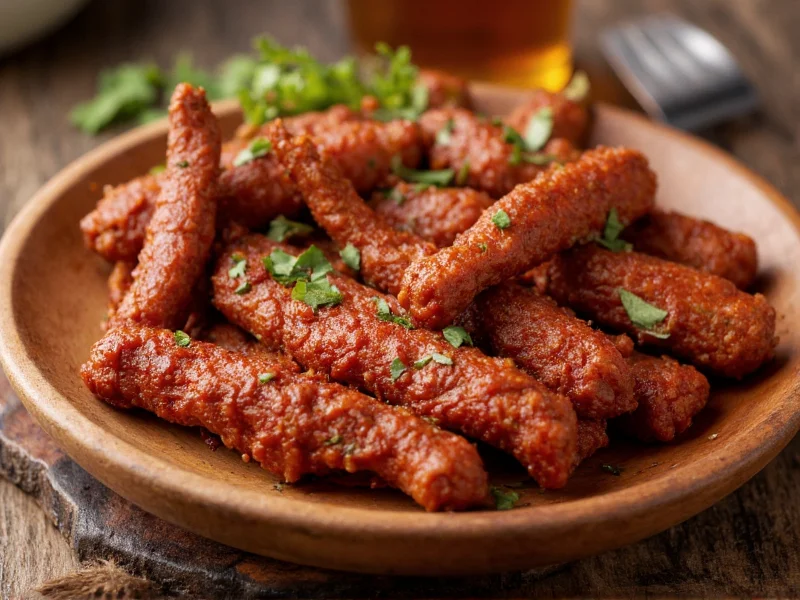When exploring Mexican cuisine, understanding the flavor profile of adobada is essential for both food enthusiasts and those with spice sensitivity. This popular dish, often featured in tacos and burritos, derives its distinctive taste from a complex marinade rooted in centuries of culinary tradition.
What Exactly Is Adobada?
Adobada (sometimes spelled adobado) is a Mexican preparation method where meat—typically pork—is marinated in a rich, reddish sauce made from dried chilies, spices, and vinegar. The term comes from the Spanish word "adobar," meaning "to marinate" or "to pickle." While similar to Filipino adobo, Mexican adobada has its own unique flavor profile and preparation techniques.
Key Ingredients That Determine Spiciness
The heat level in adobada primarily comes from the chilies used in the marinade. Understanding these components helps answer the question is adobada spicy Mexican food in different contexts:
| Chili Type | Heat Level (Scoville) | Flavor Profile | Common Use in Adobada |
|---|---|---|---|
| Guajillo | 2,500-5,000 | Fruity, tangy, berry-like | Base chili in most recipes |
| Árbol | 15,000-30,000 | Nutty, slightly smoky | Added for significant heat |
| Ancho | 1,000-2,000 | Sweet, raisin-like | Mild alternative |
| Chipotle | 2,500-8,000 | Smoky, earthy | For smoky variations |
Regional Variations in Heat Level
When considering how hot is adobada across different regions, notable variations exist:
- Baja California style: Typically milder, focusing on guajillo chilies with minimal árbol, making it accessible for those asking is adobada spicy enough for heat lovers
- Central Mexico preparation: Often includes both guajillo and árbol chilies, creating moderate to high heat that answers is pork adobada spicy with a definite yes
- Home recipes: Vary widely based on family preferences—some completely omit hotter chilies for a mild adobada experience
Adobada vs. Similar Dishes: Understanding the Heat Difference
Many confuse adobada with other Mexican preparations. Understanding these distinctions helps clarify adobada heat level explained in context:
- Adobada vs. Al Pastor: While both use similar marinades, al pastor often includes pineapple which counteracts heat, making it generally milder than traditional adobada
- Adobada vs. Regular Taco Meat: Standard taco meat uses cumin and paprika without chilies, making it significantly milder than adobada which answers is adobada spicier than regular taco meat with a clear yes
- Adobada vs. Mole: Mole contains chocolate which balances heat, while adobada's vinegar base can intensify the perception of spiciness
Customizing Adobada for Different Palates
One of the advantages of adobada is its adaptability. When exploring mild adobada recipe options, consider these adjustments:
- Reduce or eliminate árbol chilies while maintaining guajillo for flavor without intense heat
- Add roasted tomatoes or tomatillos to balance acidity and reduce perceived spiciness
- Increase the vinegar-to-chili ratio to distribute heat more evenly
- Include dairy-based elements like crema when serving to counteract heat
Serving Suggestions Based on Spiciness
Understanding adobada sauce spiciness level helps create balanced meals:
- For traditional spicy adobada: Pair with cooling elements like avocado, lime crema, and crisp lettuce
- With medium-heat versions: Complement with mild beans and rice to balance the palate
- For mild preparations: Enhance with fresh salsa or hot sauce on the side for those seeking more heat
- Always serve with lime wedges—citrus helps cut through both the richness and any spiciness
Authentic Preparation vs. Restaurant Interpretations
When determining is adobada spicy in different settings, note these distinctions:
- Traditional home cooking often features more controlled heat levels based on family preferences
- Restaurant versions may standardize to medium heat to accommodate diverse customers
- Street food preparations sometimes increase heat as a preservative measure in warmer climates
- Commercial adobada products (like marinades) frequently reduce spiciness for broader market appeal
FAQ Section
Is adobada always spicy?
No, adobada isn't always spicy. While traditional recipes include chilies that provide heat, many versions—particularly in Baja California and family recipes—use mild chilies like ancho or adjust ratios to create a flavorful but not spicy dish. The spiciness level depends entirely on the specific chilies used and their proportions.
How can I tell if adobada will be spicy before ordering?
When ordering adobada, ask specifically about the chilies used in the marinade. If the menu mentions árbol, de árbol, or simply "spicy" adobada, expect significant heat. Menus specifying guajillo-only or "mild" preparation typically indicate lower spiciness. In many authentic Mexican restaurants, staff can adjust spice levels upon request.
Is adobada spicier than regular taco meat?
Yes, traditional adobada is typically spicier than standard taco meat. Regular taco meat uses ground beef with cumin, paprika, and oregano without chilies, while adobada's marinade contains dried chilies that provide noticeable heat. However, mild adobada variations can be comparable in spiciness to well-seasoned taco meat.
Can I make adobada less spicy after it's prepared?
Yes, you can reduce adobada's spiciness after preparation by adding dairy elements like Mexican crema or sour cream, which contain casein that binds to capsaicin. Additional ingredients that help include avocado, lime juice, or even a small amount of sugar. Serving with rice and beans also helps balance the heat when eating.
Why does adobada sometimes taste spicier than expected?
Adobada may taste spicier than expected due to the vinegar content in the marinade, which enhances the perception of heat. Additionally, when cooked, the chilies' oils concentrate, intensifying the spiciness. The absence of cooling elements like avocado or crema when serving can also make the heat more pronounced than anticipated.











 浙公网安备
33010002000092号
浙公网安备
33010002000092号 浙B2-20120091-4
浙B2-20120091-4